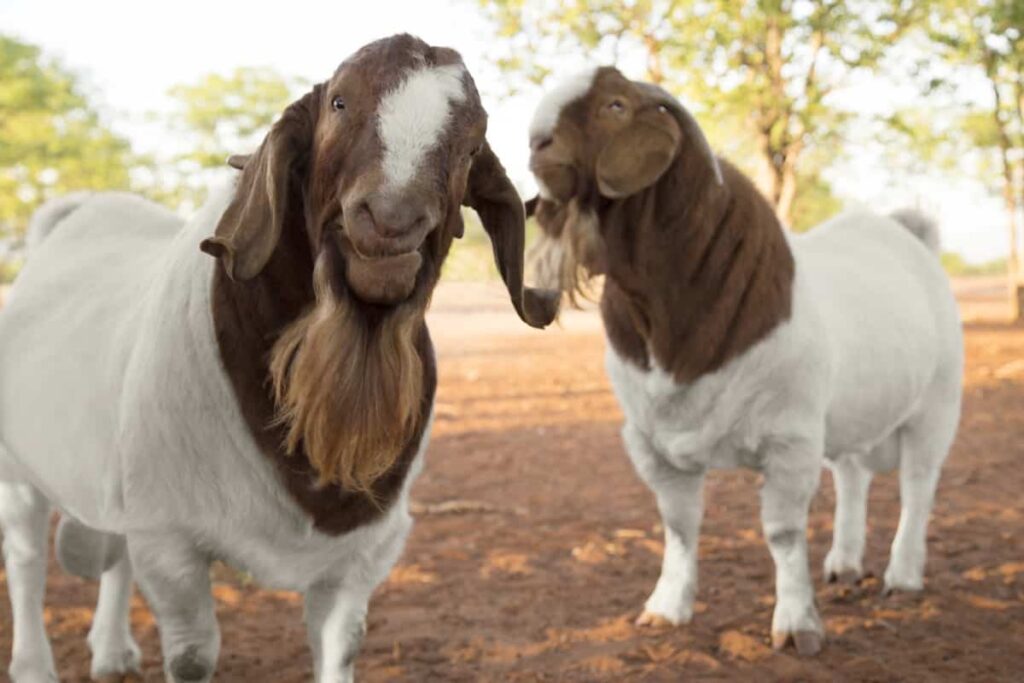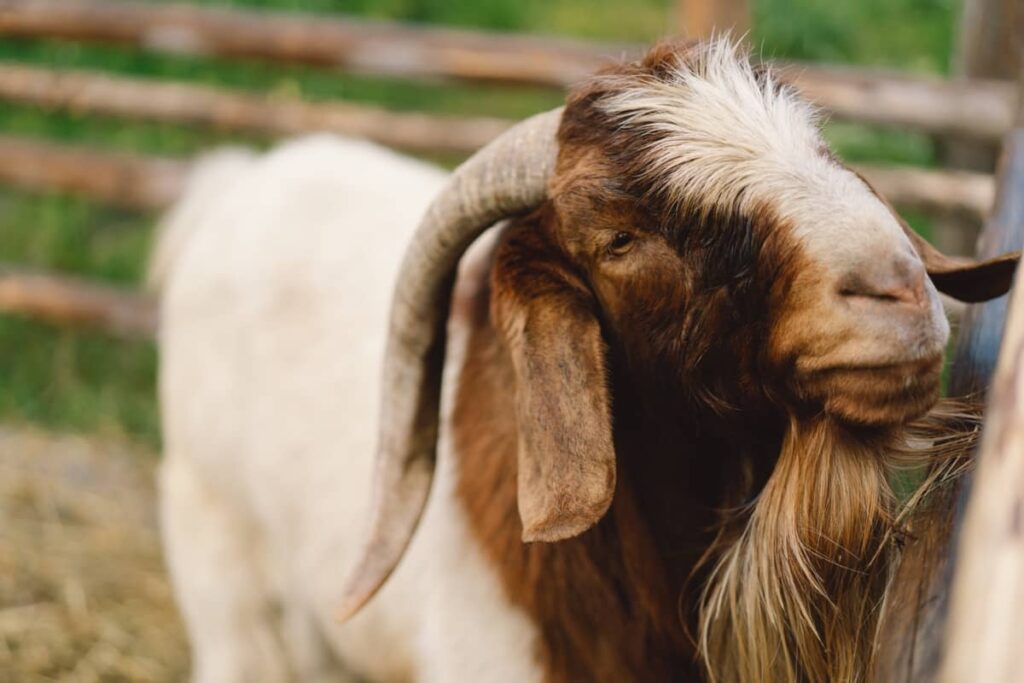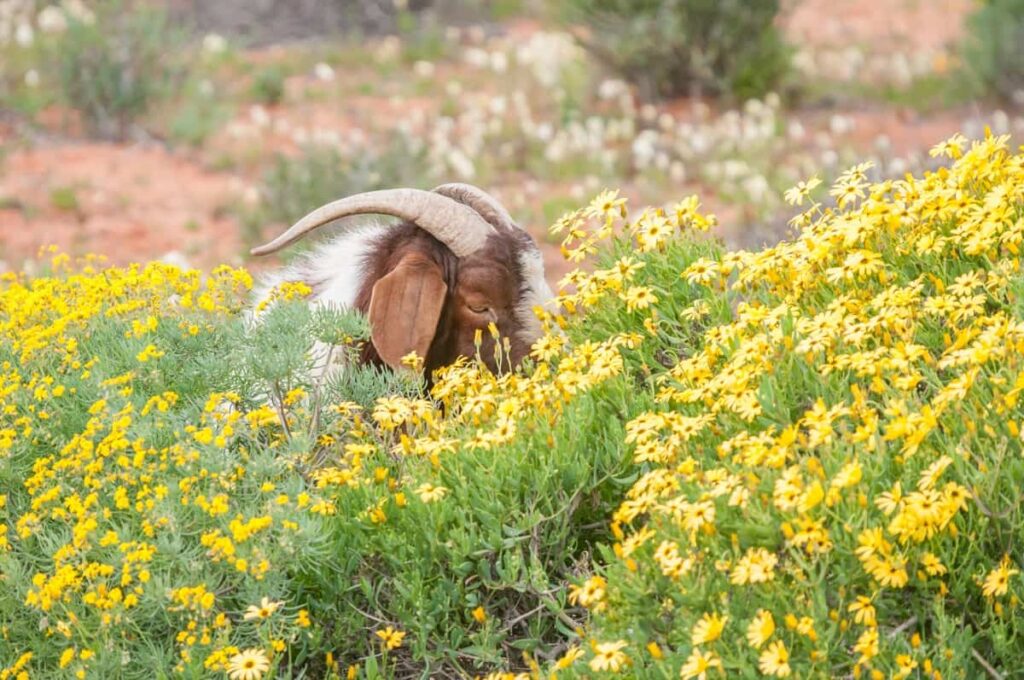Raising goats as a source of income has become increasingly common in recent years. It requires little in the way of initial capital while yielding substantial profits. The costs and benefits of goat farming for herd sizes ranging from 10 goats to 500 goats will be analyzed in this report. Producing goats for their meat, milk, and hides is a profitable and environmentally friendly business. The demand for these products is increasing daily due to the growing population and changing dietary habits. Moreover, goat farming requires less Space and is relatively easier to manage than other livestock businesses.
What is Goat Farming?
Goat farming is a form of animal husbandry that involves raising and breeding domestic goats (Capra aegagrus hircus) for their meat, milk, fiber, and skins. It is a suitable production option for low-quality grazing lands and can be integrated with other livestock farming, such as sheep and cattle. Goats are known for efficiently converting sub-quality grazing materials into quality lean meat and can be raised in small areas of pasture with limited resources.
Advantages and Benefits of Goat Farming
- Less Space Required: Goats are smaller than other livestock and require less space for accommodation. They can do well in different environments with minimum facilities.
- Many Breeds Available: There are many breeds of goats available, each with unique characteristics. You can choose the breed that suits your production purpose and availability in your area.
- Numerous Utilities: Goats are multi-purpose animals raised for meat, milk, skin, fiber, manure, and as pets.
- Low Feed Requirements: Goats require less feed due to their smaller size, and some breeds can survive on low-quality feeds.
- Easy to Care: Depending on the breed, goats require less care and management than other domestic animals. They are active and can take care of themselves.
- Climate Adaptability: Goats can adapt to various climate conditions, making them suitable for farming in various regions.
- Fast Growth Rate: Goats grow faster and mature earlier than other livestock, making them profitable for breeding and slaughtering.
- Hardy Animals: Goats are strong and hardy animals, capable of surviving in poor conditions and resisting common diseases.
- Low Caring Costs: Goats require less care and management, resulting in lower caring costs.
- Easy Marketing: Goat products have high demand in domestic and international markets, making it easy to market them.
- Great ROI: Goat farming is profitable, and the return on investment is high.
- Less Risk: Goat farming requires less initial investment and operating costs, making it a relatively risk-free business.
- Poverty Eradication: Goat farming can help eradicate poverty in less developed countries by providing a profitable business opportunity.
- Employment Opportunities: Goat farming can create employment opportunities for educated, unemployed people, making it a great alternative to traditional jobs.
In case you missed it: How to Make Silage for Livestock: Business Plan, Preparation Process for Goats, Sheep, Pigs, and Cows

Goat Farming Project Report
Project Description
Goat rearing is a multi-functional enterprise contributing to the economy and nutrition of India’s landless, small, and marginal farmers.
- The demand for goat meat is high, and commercial goat farms have been established in various regions.
- The project location should have easy access to the main road and an assured market annually.
Housing
Low-cost housing will be constructed on a raised platform using bamboo/wooden poles or concrete pillars.
- The floor and side walls will be made of wooden material, while the roof will be thatched with coconut leaves, grass, or asbestos sheets.
- The average floor space per kid is 0.75 to 1 sq. meter, and the floor should have at least 1 cm between bamboo/wooden planks to allow passage of dung and urine down to the ground.
Feed and Fodder Cultivation
Fertile land with assured irrigation facilities is necessary for successful fodder crop cultivation and to provide good quality green fodders throughout the year.
- Water: Good quality fresh water is essential for animal drinking and cleaning.
- Labor: Honest, economic, and regular supplies of labor must be available.
- Veterinary Aid: Veterinary aid and breeding center facilities should be available near the proposed goat farm.
- Market Potential: Over 80% of the population are meat eaters, with a distinct shift in consumption patterns towards non-veg.
- The demand for goat meat is rapidly increasing faster than the growth in the population, making goat farming a profitable venture.
- India has the first position regarding goat population and milk production, and goat meat export potential is huge.
SWOT Analysis
Strengths
- Low labor requirement and low initial investment.
- Multi-functional animals contribute to the economy and nutrition of landless farmers.
- Goats can survive in harsh environments and utilize low-fertility lands where no other crop can be grown.
- No religious taboo against goat slaughter and meat consumption in the country.
- Goat milk is easy to digest, and goats create employment for the rural poor.
- Strong creatures resist various diseases and require minimal facilities and amenities.
- High fertility rate and probability of producing twins.
- Less risk associated with drought compared to other livestock breeds.
- Enhance the health of grazing land and minimize encroachment of bushes.
- Goat meat is low in fat, cholesterol, and calories, providing health benefits to consumers.
In case you missed it: Sustainable Goat Farming: Business Plan, Benefits, and Requirements

Opportunities
The high and ready goat meat market confirmed the ever-increasing market price.
Weaknesses
- Large-scale, organized goat farming has yet to become a successful venture.
- The high mortality rate of goat kids.
Threats
The goat population is increasing, but there is a drastic decline in the grazing land availability is a big challenge to the industry.
Investment and Profit for 10 Goats
- Goat breed: Boer goat
- Number of goats: 10
Investment
| Cost of purchasing 10 Boer goats | INR 1,50,000 |
| Cost of constructing a goat shed | INR 50,000 |
| Cost of purchasing fodder for the goats for one year | INR 1,00,000 |
| Cost of veterinary care and medicines for one year | INR 20,000 |
| Total investment | INR 3,20,000 |
Profit
| The selling price of 10 Boer goats after one year | INR 4,50,000 |
| Cost of fodder and veterinary care for one year | INR 1,20,000 |
| Net profit | INR 3,30,000 |
Components Contributing to Profit
| The selling price of goats | INR 4,50,000 |
| Cost of fodder | INR 1,00,000 |
| Cost of veterinary care and medicines | INR 20,000 |
| Total cost | INR 1,20,000 |
| Net profit | INR 3,30,000 |
Goat farms can make big profits. Goat breed, market demand, fodder, veterinary care pricing, and management strategies will affect expenses and earnings.
Tips for Maximizing Profit with a Small Herd
- Focus on High-Value Breeds – Breeds like Boer and Nubian are in high demand and can fetch a higher price.
- Utilize Good Grazing Practices: Goats are natural grazers, so providing access to high-quality pasture and rotating grazing areas can reduce feed costs.
- Explore Alternative Revenue Streams: Besides selling goats, consider selling goat milk, cheese, or other value-added products to increase revenue.
- Control Operating Costs: Look for ways to reduce operating costs by using efficient feeding practices, keeping the herd healthy, and minimizing labor costs.
- Plan for the Future: Invest in breeding and expanding the herd to increase revenue in the long term.
Investment and Profit for 20 Goats
- Goat breed: Jamunapari
- Number of goats: 20
Initial investment
| Cost of each goat | Rs. 25,000 |
| The total cost of 20 goats | Rs. 5,00,000 |
Feed and Healthcare Costs
| Cost of feed per goat per month | Rs. 1,500 |
| Cost of healthcare per goat per year | Rs. 2,000 |
| The total cost of feed and healthcare for 20 goats per year | is Rs. 4,80,000 |
In case you missed it: How to Start Goat Farming in Bangladesh: Business Plan, Breeds, Cost, Profits, and Requirements

Breeding and Selling
| Average gestation period | 150 days |
| Average litter size | 2 |
| Average selling price per goat | Rs. 50,000 |
| Number of times goats can breed per year | 2 |
| Number of kids born per year | 40 |
| Total revenue from selling goats per year | Rs. 20,00,000 |
Profit Calculation
- Total revenue from selling goats per year: Rs. 20,00,000
- The total cost of feed and healthcare for 20 goats per year is Rs. 4,80,000
- Total initial investment: Rs. 5,00,000
- Profit per year: Rs. 10,20,000
Based on this example, goat farming can yield five lakhs or more, especially with a high-quality breed like Jamunapari. Market demand, resource availability, and management techniques can affect earnings.
Investment and Profit for 50 Goats
| Breed of goat | Boer goats |
| Initial cost per goat | Rs. 20,000 |
| Cost of feed per goat per day | Rs. 60 |
| Breeding cycle | 6 months |
| Average litter size | 2 kids per goat |
| Average mortality rate | 5% |
| Selling price per kg of live weight | Rs. 400 |
Investment
| Cost of 50 goats | Rs. 10,00,000 |
| Cost of housing and equipment | Rs. 1,50,000 |
| Cost of feed for 6 months | Rs. 5,40,000 |
| Total investment | Rs. 16,90,000 |
In case you missed it: How to Care for Dairy Goats: Shelter/Housing, Fencing, Feeding, and Disease Control

Profit
| Total weight gain of 50 goats in 6 months | 4,500 kg (assuming 90 kg per goat) |
| Total revenue from selling goats | Rs. 18,00,000 (4,500 kg x Rs. 400 per kg) |
| Cost of replacement for 5% mortality rate | Rs. 50,000 (5% of 50 goats x Rs. 20,000 per goat) |
| Total profit | Rs. 12,60,000 (Rs. 18,00,000 – Rs. 16,90,000 – Rs. 50,000) |
Components Contributing to Profit
- Selling price per kg of live weight: Rs. 400
- Average litter size: 2 kids per goat
- Low mortality rate: 5%
- Proper housing and equipment
- Quality feed and nutrition
Note: This is just an example based on certain values, and actual results may vary depending on various factors such as the breed of goat, market conditions, feed quality, labor costs, etc.
Investment and Profit for 100 Goats
Initial Investment
| Purchase of 100 goats | Rs. 20,00,000 |
| Construction of sheds and fencing | Rs. 3,00,000 |
| Purchase of feeding and milking equipment | Rs. 2,00,000 |
| Total initial investment | Rs. 25,00,000 |
In case you missed it: How to Apply for Bank Goat Farming Loan in India: Procedure, Documents, Eligibility, and Interest Rate for SBI, Canara, HDFC, and Mudra

Goat Breed
Boer Goats, a breed known for their fast growth rate, high fertility, and good meat quality
Feed Costs
| Daily feed requirement per goat | 2-3 kg of fodder and 0.5 kg of concentrate |
| Cost of fodder | Rs. 25 per kg |
| Cost of concentrate | Rs. 50 per kg |
| Total daily feed cost for 100 goats | Rs. 7,500 – Rs. 11,250 |
| Monthly feed cost | Rs. 2,25,000 – Rs. 3,37,500 |
Veterinary Costs
- Routine checkups and vaccinations: Rs. 10,000 per month
- Treatment costs for sick or injured goats: variable
Milk Production
| Average milk production per goat per day | 2-3 liters |
| The selling price of goat milk | Rs. 60 per liter |
| Total monthly milk production from 100 goats | 6,000 – 9,000 liters |
| Total monthly revenue from milk sales | Rs. 3,60,000 – Rs. 5,40,000 |
Meat Production
| Average weight gain of goats per month | 5-6 kg |
| Selling price of live goats | Rs. 400 per kg |
| Total monthly weight gain of 100 goats | 500-600 kg |
| Total monthly revenue from live goat sales | Rs. 2,00,000 – Rs. 2,40,000 |
Profit Calculation
| Total monthly expenses (feed and vet costs) | Rs. 2,35,000 – Rs. 3,47,500 |
| Total monthly revenue (milk and live goat sales) | Rs. 5,60,000 – Rs. 7,80,000 |
| Monthly profit | Rs. 3,25,000 – Rs. 4,32,500 |
| Annual profit | Rs. 39,00,000 – Rs. 51,90,000 |
Note: The above figures are estimates, and actual profits may vary depending on market demand, feed and veterinary costs, and weather conditions.
Investment and Profit for 500 Goats
Initial investment
| Purchase of 500 goats (assuming a price of Rs. 5000 per goat) | Rs. 25,00,000 |
| Construction of housing and fencing | Rs. 10,00,000 |
| Purchase of equipment and supplies | Rs. 5,00,000 |
| Total initial investment | Rs. 40,00,000 |
In case you missed it: Contract Goat Farming in India: How to Earn an Extra Income from this Long-Term Investment

Annual Expenses
| Feed and supplements for 500 goats | Rs. 30,00,000 |
| Veterinary care and medicine | Rs. 1,00,000 |
| Labor (including salary, benefits, and taxes) | Rs. 10,00,000 |
| Utilities (electricity, water, etc.) | Rs. 2,00,000 |
| Insurance | Rs. 50,000 |
| Total annual expenses | Rs. 43,50,000 |
Revenue
| Sale of 500 goats (assuming a price of Rs. 10,000 per goat) | Rs. 50,00,000 |
| Sale of goat milk (assuming an average yield of 2 liters per day per goat and a price of Rs. 50 per liter) | Rs. 18,25,000 |
| Sale of goat meat (assuming a price of Rs. 800 per kg and an average weight of 20 kg per goat) | Rs. 40,00,000 |
| Total revenue | Rs. 1,08,25,000 |
Profit
- Revenue (Rs. 1,08,25,000) minus expenses (Rs. 43,50,000) = Rs. 64,75,000
- Subtract initial investment (Rs. 40,00,000) = Rs. 24,75,000
- Assuming a breakeven point of 2 years, total profit over five years (after the initial investment) = Rs. 2,48,75,000
Note: The above figures are estimates, and actual profits may vary depending on market demand, feed and veterinary costs, and weather conditions.
Conclusion
Farming goats is a profitable venture that can bring profit money. The higher the number of goats, the more money you’ll have to put in initially, but the more you’ll make each year. Whether starting with 10 goats or 500, goat farming can be a rewarding commercial venture with a proper method of planning and management.
- How to Raise Pigs in Your Own Backyard: A Comprehensive Guide
- Budget Friendly Sheep Shed Ideas: Cheap and Low-Cost Tips
- How Much Do Cattle Farmers Make: Revenue Streams in Cattle Farming
- Management Pests and Diseases in Your Cotton Field
- Sheep Farming Business Plan for Beginners
- Aquaponic Farming at Home: A Step-By-Step Guide
- Profitable Village Farming Business Ideas in 2024
- High-Yield Aquaculture: Fast-Growing Fish for Farming
- Effective Fish Pond Construction Techniques for Beginners
- Irrigation and Water Management in Pineapple Farming
- Blossom to Harvest: Mastering Flowering and Pollination in Papaya Farming
- Pig Fattening Essentials: From Selection to Sale for Beginners
- Raising Wagyu Cattle: A Complete Guide for Premium Beef Production
- Soil Types and Their Water Holding Capacity
- Optimizing Irrigation Schedules for Coconut Groves for Enhanced Yield
- Espresso Your Garden: Coffee Grounds for Healthier Acid-Loving Plants
- The Best Soil Mix for Snake Plants: How to Mix Your Own Snake Plant Soil
- Green Thumb Success: Expert Tips for Cultivating Greenhouse Beans All Year Round
- Bloom All Year Round: The Ultimate Guide to Indoor Hyacinth Care
- Eco-Friendly Gardening: How to Make Liquid Fertilizer from Kitchen Waste
- Ultimate Guide to Grow Anise in Pots: Explore Seed Propagation to Harvesting
- Guide to Raising Chester White Pigs: Discover Breed Facts to Growth Management
- Mastering the Elegance: The Ultimate Guide to Weeping Cherry Tree Care, Planting, and Maintenance
- Ultimate Guide to Planting Garlic in Grow Bags: Growing Strategies for Beginners
- How to Fix Spider Plant Leaf-Related Problems: Natural and Organic Remedies
- 10 Reasons Why Your Tulsi Plant is Shedding Leaves: Home Remedies and Solutions
- Optimizing Growth and Yield: The Advantages of Palm Bunch Ash Fertilizer
- Utilizing Neem Oil Extract as a Natural Pesticide for Hydrangea
- From Soil to Harvest: Various Ways in Which Farmers Can Use AI Tools
- Steps to Encourage and Induce Citrus Flowers: A Comprehensive Guide
- How to Fix Snake Plant Leaf-Related Issues: Natural and Organic Remedies
- Transform Your Garden into a Fragrant Oasis with Raat Ki Rani (Night Blooming Jasmine)
- Discover the Ideal Chicken Breeds for Philippine Farms
- How to Create a Poultry Egg Farm Business Plan for Profits
- Grow Lemon Cucumbers Like a Pro: Insider Techniques for Bountiful Yields
- Ultimate Guide to Caring for Your Pink Princess Philodendron: Tips for Thriving Variegation

Very good information. Thanks